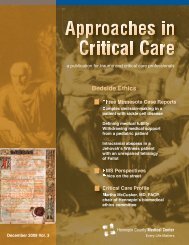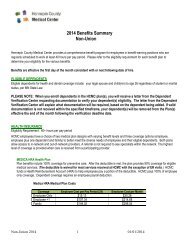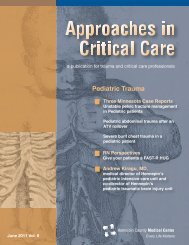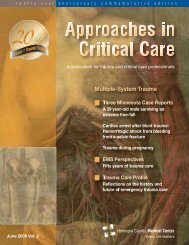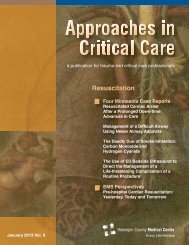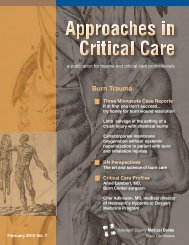Ischemic Stroke - Hennepin County Medical Center
Ischemic Stroke - Hennepin County Medical Center
Ischemic Stroke - Hennepin County Medical Center
Create successful ePaper yourself
Turn your PDF publications into a flip-book with our unique Google optimized e-Paper software.
EMS Perspectives<br />
time from a mere 3 hours from symptom onset<br />
to 6-12 hours from symptom onset, depending<br />
on the location of the insult and other factors.<br />
An effective EMS response to stroke remains<br />
a key factor in reducing mortality and morbidity<br />
from stroke.<br />
What is stroke?<br />
<strong>Stroke</strong> is defined as an acute loss of perfusion<br />
to the vascular territory of the brain, resulting<br />
in ischemia and a corresponding loss of neurologic<br />
function.<br />
The cause of stroke can vary and greatly<br />
impacts the management of the patient with<br />
stroke. Approximately 83% of all strokes are<br />
ischemic and secondary to either a thrombus<br />
or embolism. The other 17% are secondary to<br />
an intracerebral hemorrhage and subarachnoid<br />
hemorrhage. While the prehospital treatment is<br />
essentially the same for ischemic and hemorrhagic<br />
stroke patients, understanding the differences<br />
is important as it will help direct the<br />
assessment of the patient on arrival at the<br />
emergency department.<br />
Similar to stroke, a transient ischemic attack<br />
(sometimes called a TIA or “mini-stroke”) is<br />
defined as temporary neurologic dysfunction<br />
as a result of vascular occlusion. Symptoms<br />
normally resolve in less than one hour. While<br />
neurologic function returns to normal after a<br />
TIA, these events are strong predictors of a<br />
future stroke.<br />
We often think of stroke as a disease of elders.<br />
While it is most prevalent in people over<br />
65, stroke can occur at any age. Younger victims<br />
of stroke often have notable risk factors,<br />
such as smoking, preexisting coagulopathy,<br />
the use of oral contraceptives, and the use of<br />
illicit drugs (especially cocaine). Age alone<br />
does not allow stroke to be ruled out.<br />
Patients with stroke often present with a sudden<br />
onset of numbness or weakness of the<br />
face, arm, or leg, particularly on one side.<br />
They may have difficulty speaking (expressive<br />
aphasia/dysphasia), or difficulty understanding<br />
language (receptive aphasia/dysphasia). Gait<br />
and vision disturbances also may occur. In<br />
addition, sudden headache, decreased level of<br />
consciousness, nausea and vomiting, hypertension,<br />
or seizure activity may be present.<br />
The latter signs are more commonly associated<br />
with hemorrhagic stroke but may occur in<br />
any patient with acute stroke.<br />
When assessing the history of a stroke patient,<br />
determining the time of onset is critical.<br />
Providers should not only ask the patient but<br />
bystanders, family members, or first responders<br />
who may have witnessed the incident. If<br />
a definitive time of onset cannot be established,<br />
onset time must be estimated using the<br />
last time the patient was seen at their neurologic<br />
baseline.<br />
In addition to history related to the acute<br />
symptoms, it is important to obtain other information<br />
as well. Important factors include:<br />
Co-morbid conditions (especially diabetes<br />
or hypertension)<br />
Prior history (including recent myocardial<br />
infarction or history of atrial fibrillation)<br />
Recent stroke or prior TIAs<br />
Recent surgery<br />
Bleeding disorders<br />
Recent trauma<br />
Document any medications the patient takes.<br />
Pay particular attention to antihypertensives,<br />
insulin, or anticoagulants.<br />
14 | Approaches in Critical Care | December 2008




